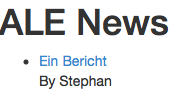Learning AngularJS to create the ALE News web client
This blog post is part of a series about the development of ALE News using an approach to software development called Acceptance Test-Driven Development. For an overview please see the introductory article.
The ALE News web client will be implemented using the AngularJS web framework as a single page web application in JavaScript. To help me with the layout I’m going to use Twitter Bootstrap. I added NodeJS, NPM and Bower to my system and created a simple first HTML page:
<html>
<head>
<title>ALE News</title>
<link rel="stylesheet" href="bower_components/bootstrap/dist/css/bootstrap.css">
<link rel="stylesheet" href="app/css/main.css">
</head>
<body ng-app ng-init="name = 'World'">
<h1>Hello !</h1>
<script src="bower_components/jquery/dist/jquery.js"></script>
<script src="bower_components/bootstrap/dist/js/bootstrap.js"></script>
<script src="bower_components/angular/angular.js"></script>
</body>
</html>
Running multiple web applications at the same time
As the web client will consume the article service, which comes in the form of another WAR file, I added the following Jetty configuration to my pom.xml. It will deploy both WAR files to separate context paths.
<build>
<finalName>web-client</finalName>
<plugins>
<plugin>
<groupId>org.mortbay.jetty</groupId>
<artifactId>jetty-maven-plugin</artifactId>
<configuration>
<webApp>
<contextPath>/web-client</contextPath>
</webApp>
<contextHandlers>
<contextHandler implementation="org.eclipse.jetty.webapp.WebAppContext">
<war>${project.basedir}/../article-service/target/article-service.war</war>
<contextPath>/article-service</contextPath>
</contextHandler>
</contextHandlers>
</configuration>
</plugin>
</plugins>
</build>
With that in place I can do mvn jetty:run inside the web-client module and will get this output on the console:
2014-09-23 14:47:05.985:INFO:oejs.Server:jetty-8.1.16.v20140903
2014-09-23 14:47:06.157:INFO:oejpw.PlusConfiguration:No Transaction manager found - if your webapp requires one, please configure one.
2014-09-23 14:47:06.708:INFO:oejw.WebInfConfiguration:Extract jar:file:/Users/sns/Documents/dev/ale-news-atdd/source/article-service/target/article-service.war!/ to /Users/sns/Documents/dev/ale-news-atdd/source/article-service/target/article-service
2014-09-23 14:47:08.076:WARN:oejsh.RequestLogHandler:!RequestLog
2014-09-23 14:47:08.090:INFO:oejs.AbstractConnector:Started SelectChannelConnector@0.0.0.0:8080
A quick test reveals that both applications can be accessed through their URL.
What is the simplest thing that could possibly work
I don’t have any experience with the AngularJS web framework. With the help of their tutorial and some basic knowledge of JavaScript I was able to create a minimalistic application that consumes the article service and asks for a list of articles in the archive.
Here is the screen output from this simplistic webapp:

This output is produced by the following HTML in index.html.
<html ng-app="articleApp">
<head>
<title>ALE News</title>
<link rel="stylesheet" href="bower_components/bootstrap/dist/css/bootstrap.css">
<link rel="stylesheet" href="app/css/main.css">
</head>
<body ng-controller="ArticleListCtrl">
<h1>ALE News</h1>
<ul>
<li ng-repeat="article in articles">
<a href=""></a><br/>
By
</li>
</ul>
<script src="bower_components/jquery/dist/jquery.js"></script>
<script src="bower_components/bootstrap/dist/js/bootstrap.js"></script>
<script src="bower_components/angular/angular.js"></script>
<script src="app/js/article-service.js"></script>
</body>
</html>
The ArticleListCtrl is defined in the article-service.js file:
var articleApp = angular.module('articleApp', []);
articleApp.controller('ArticleListCtrl', ['$scope', '$http',
function ($scope, $http) {
$http.get('http://localhost:8080/article-service/article').success(function(data) {
$scope.articles = data;
});
}]);
Where did the data come from?
As the article service has only a fake data storage, a simple static instance variable, a GET request to obtain a list of articles will return an empty array. I used the CocoaRestClient to submit data to it via the POST method. That way I was able to use the service from the prototype web client.
So far I have experimented a little bit in order to learn more about how to use AngularJS. There was no point yet in writing a specification for the web client. That will follow next.
| Previous | 25 Sep 2014 | Next |
This article has been posted to social media sites. There might be comments. Just follow the links:








